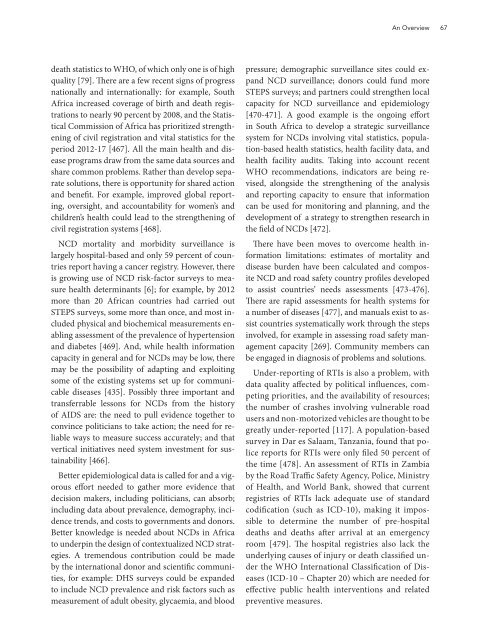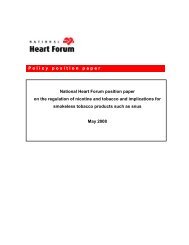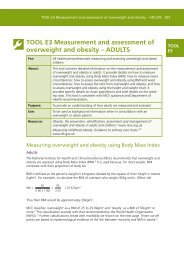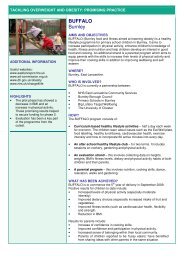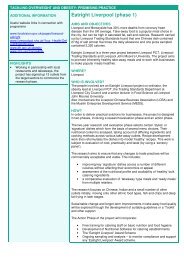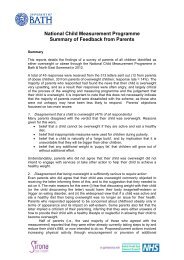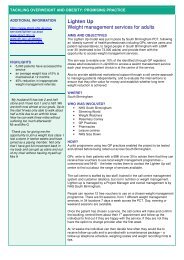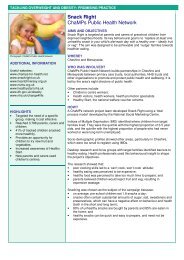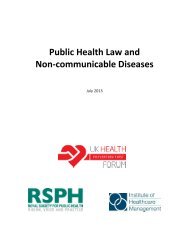The Challenge of Non-Communicable Diseases and Road Traffic ...
The Challenge of Non-Communicable Diseases and Road Traffic ...
The Challenge of Non-Communicable Diseases and Road Traffic ...
Create successful ePaper yourself
Turn your PDF publications into a flip-book with our unique Google optimized e-Paper software.
An Overview 67<br />
death statistics to WHO, <strong>of</strong> which only one is <strong>of</strong> high<br />
quality [79]. <strong>The</strong>re are a few recent signs <strong>of</strong> progress<br />
nationally <strong>and</strong> internationally: for example, South<br />
Africa increased coverage <strong>of</strong> birth <strong>and</strong> death registrations<br />
to nearly 90 percent by 2008, <strong>and</strong> the Statistical<br />
Commission <strong>of</strong> Africa has prioritized strengthening<br />
<strong>of</strong> civil registration <strong>and</strong> vital statistics for the<br />
period 2012-17 [467]. All the main health <strong>and</strong> disease<br />
programs draw from the same data sources <strong>and</strong><br />
share common problems. Rather than develop separate<br />
solutions, there is opportunity for shared action<br />
<strong>and</strong> benefit. For example, improved global reporting,<br />
oversight, <strong>and</strong> accountability for women’s <strong>and</strong><br />
children’s health could lead to the strengthening <strong>of</strong><br />
civil registration systems [468].<br />
NCD mortality <strong>and</strong> morbidity surveillance is<br />
largely hospital-based <strong>and</strong> only 59 percent <strong>of</strong> countries<br />
report having a cancer registry. However, there<br />
is growing use <strong>of</strong> NCD risk-factor surveys to measure<br />
health determinants [6]; for example, by 2012<br />
more than 20 African countries had carried out<br />
STEPS surveys, some more than once, <strong>and</strong> most included<br />
physical <strong>and</strong> biochemical measurements enabling<br />
assessment <strong>of</strong> the prevalence <strong>of</strong> hypertension<br />
<strong>and</strong> diabetes [469]. And, while health information<br />
capacity in general <strong>and</strong> for NCDs may be low, there<br />
may be the possibility <strong>of</strong> adapting <strong>and</strong> exploiting<br />
some <strong>of</strong> the existing systems set up for communicable<br />
diseases [435]. Possibly three important <strong>and</strong><br />
transferrable lessons for NCDs from the history<br />
<strong>of</strong> AIDS are: the need to pull evidence together to<br />
convince politicians to take action; the need for reliable<br />
ways to measure success accurately; <strong>and</strong> that<br />
vertical initiatives need system investment for sustainability<br />
[466].<br />
Better epidemiological data is called for <strong>and</strong> a vigorous<br />
effort needed to gather more evidence that<br />
decision makers, including politicians, can absorb;<br />
including data about prevalence, demography, incidence<br />
trends, <strong>and</strong> costs to governments <strong>and</strong> donors.<br />
Better knowledge is needed about NCDs in Africa<br />
to underpin the design <strong>of</strong> contextualized NCD strategies.<br />
A tremendous contribution could be made<br />
by the international donor <strong>and</strong> scientific communities,<br />
for example: DHS surveys could be exp<strong>and</strong>ed<br />
to include NCD prevalence <strong>and</strong> risk factors such as<br />
measurement <strong>of</strong> adult obesity, glycaemia, <strong>and</strong> blood<br />
pressure; demographic surveillance sites could exp<strong>and</strong><br />
NCD surveillance; donors could fund more<br />
STEPS surveys; <strong>and</strong> partners could strengthen local<br />
capacity for NCD surveillance <strong>and</strong> epidemiology<br />
[470-471]. A good example is the ongoing effort<br />
in South Africa to develop a strategic surveillance<br />
system for NCDs involving vital statistics, population-based<br />
health statistics, health facility data, <strong>and</strong><br />
health facility audits. Taking into account recent<br />
WHO recommendations, indicators are being revised,<br />
alongside the strengthening <strong>of</strong> the analysis<br />
<strong>and</strong> reporting capacity to ensure that information<br />
can be used for monitoring <strong>and</strong> planning, <strong>and</strong> the<br />
development <strong>of</strong> a strategy to strengthen research in<br />
the field <strong>of</strong> NCDs [472].<br />
<strong>The</strong>re have been moves to overcome health information<br />
limitations: estimates <strong>of</strong> mortality <strong>and</strong><br />
disease burden have been calculated <strong>and</strong> composite<br />
NCD <strong>and</strong> road safety country pr<strong>of</strong>iles developed<br />
to assist countries’ needs assessments [473-476].<br />
<strong>The</strong>re are rapid assessments for health systems for<br />
a number <strong>of</strong> diseases [477], <strong>and</strong> manuals exist to assist<br />
countries systematically work through the steps<br />
involved, for example in assessing road safety management<br />
capacity [269]. Community members can<br />
be engaged in diagnosis <strong>of</strong> problems <strong>and</strong> solutions.<br />
Under-reporting <strong>of</strong> RTIs is also a problem, with<br />
data quality affected by political influences, competing<br />
priorities, <strong>and</strong> the availability <strong>of</strong> resources;<br />
the number <strong>of</strong> crashes involving vulnerable road<br />
users <strong>and</strong> non-motorized vehicles are thought to be<br />
greatly under-reported [117]. A population-based<br />
survey in Dar es Salaam, Tanzania, found that police<br />
reports for RTIs were only filed 50 percent <strong>of</strong><br />
the time [478]. An assessment <strong>of</strong> RTIs in Zambia<br />
by the <strong>Road</strong> <strong>Traffic</strong> Safety Agency, Police, Ministry<br />
<strong>of</strong> Health, <strong>and</strong> World Bank, showed that current<br />
registries <strong>of</strong> RTIs lack adequate use <strong>of</strong> st<strong>and</strong>ard<br />
codification (such as ICD-10), making it impossible<br />
to determine the number <strong>of</strong> pre-hospital<br />
deaths <strong>and</strong> deaths after arrival at an emergency<br />
room [479]. <strong>The</strong> hospital registries also lack the<br />
underlying causes <strong>of</strong> injury or death classified under<br />
the WHO International Classification <strong>of</strong> <strong>Diseases</strong><br />
(ICD-10 – Chapter 20) which are needed for<br />
effective public health interventions <strong>and</strong> related<br />
preventive measures.


